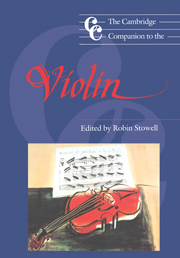Book contents
- Frontmatter
- 1 The violin and bow – origins and development
- 2 The physics of the violin
- 3 The violinists of the Baroque and Classical periods
- 4 The nineteenth-century bravura tradition
- 5 The twentieth century
- 6 The fundamentals of violin playing and teaching
- 7 Technique and performing practice
- 8 Aspects of contemporary technique (with comments about Cage, Feldman, Scelsi and Babbitt)
- 9 The concerto
- 10 The sonata
- 11 Other solo repertory
- 12 The violin as ensemble instrument
- 13 The pedagogical literature
- 14 The violin – instrument of four continents
- 15 The violin in jazz
- Appendix Principal violin treatises
- Glossary of technical terms
- Notes
- Select bibliography
- Index
6 - The fundamentals of violin playing and teaching
Published online by Cambridge University Press: 28 September 2011
- Frontmatter
- 1 The violin and bow – origins and development
- 2 The physics of the violin
- 3 The violinists of the Baroque and Classical periods
- 4 The nineteenth-century bravura tradition
- 5 The twentieth century
- 6 The fundamentals of violin playing and teaching
- 7 Technique and performing practice
- 8 Aspects of contemporary technique (with comments about Cage, Feldman, Scelsi and Babbitt)
- 9 The concerto
- 10 The sonata
- 11 Other solo repertory
- 12 The violin as ensemble instrument
- 13 The pedagogical literature
- 14 The violin – instrument of four continents
- 15 The violin in jazz
- Appendix Principal violin treatises
- Glossary of technical terms
- Notes
- Select bibliography
- Index
Summary
Preamble
As the twentieth century draws to a close, violinists are faced with a bewildering range of teaching and playing styles. Teaching rarely achieves the elevated status of the performing career except in the USA and, more notably, in the traditions of Eastern Europe. As a profession it lacks the formal training and benefits derived from systematic apprenticeship. Moreover, many players resort to violin teaching as a supplement to their main income – with the result that their lessons are invariably unstructured and idiosyncratic.
Written information on the violin fares little better. The authoritative texts of Flesch and Galamian are remarkably thorough; here the beneficiary is the specialist embarking on a solo career, not the teacher, for whom little is on offer. Subsequent authors have continued this trend, though contemporary ideas are even more acutely polarised. The books of Gerle and Jacoby champion a scientific and analytical expose of skills, while the works of Havas, Menuhin and Polnauer represent the more abstract approach, where general concepts such as Gestalt philosophy are preferred to detailed investigation. By contrast, although the Rolland and Suzuki methods are appreciably different from each other, they are both geared to the beginner and pioneer teaching en masse, involving extensive use of modern audio and visual equipment.
Serious gaps therefore exist not only for the general student of intermediate standard and modest aspiration but also for today's player and teacher, who is offered little perspective on a wide range of issues and techniques. While this chapter cannot profess to be comprehensive, it does seek to redress the balance. Its agenda, a judicious mix of new and traditional ideas, emphasises topics which are generally neglected, and makes only brief reference to those which can be easily gleaned from the main publications.
- Type
- Chapter
- Information
- The Cambridge Companion to the Violin , pp. 92 - 121Publisher: Cambridge University PressPrint publication year: 1992
- 2
- Cited by



